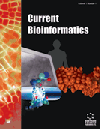- Home
- A-Z Publications
- Current Bioinformatics
- Previous Issues
- Volume 17, Issue 1, 2022
Current Bioinformatics - Volume 17, Issue 1, 2022
Volume 17, Issue 1, 2022
-
-
A Review: Computational Approaches to Design sgRNA of CRISPR-Cas9
More LessAuthors: Mohsin A. Nasir, Samia Nawaz and Jian HuangClustered regularly interspaced short palindromic repeats along with CRISPR-associated protein mechanisms preserve the memory of previous experiences with DNA invaders, in particular spacers that are embedded in CRISPR arrays between coordinate repeats. There has been a fast progression in the comprehension of this immune system and its implementations; however, there are numerous points of view that ant Read More
-
-
-
Bioinformatics Approach on Bioisosterism Softwares to be Used in Drug Discovery and Development
More LessBackground: In the rational drug development field, bioisosterism is a tool that improves lead compounds' performance, referring to molecular fragment substitution that has similar physical-chemical properties. Thus, it is possible to modulate drug properties such as absorption, toxicity, and half-life increase. This modulation is of pivotal importance in the discovery, development, identification, and interpretation of the mode Read More
-
-
-
A Review of DNA Data Storage Technologies Based on Biomolecules
More LessAuthors: Lichao Zhang, Yuanyuan Lv, Lei Xu and Murong ZhouIn the information age, data storage technology has become the key to improving computer systems. Since traditional storage technologies cannot meet the demand for massive storage, new DNA storage technology based on biomolecules attracts much attention. DNA storage refers to the technology that uses artificially synthesized deoxynucleotide chains to store and read all information, such as documents, pictures, and Read More
-
-
-
Integration of Multi-Omics Data Using Probabilistic Graph Models and External Knowledge
More LessAuthors: Bridget A. Tripp and Hasan H. OtuBackground: High-throughput sequencing technologies have revolutionized the ability to perform systems-level biology and elucidate molecular mechanisms of disease through the comprehensive characterization of different layers of biological information. Integration of these heterogeneous layers can provide insight into the underlying biology but is challenged by modeling complex interactions. Objective: We i Read More
-
-
-
Identification of Drug-Disease Associations by Using Multiple Drug and Disease Networks
More LessBackground: Drug repositioning is a new research area in drug development. It aims to discover novel therapeutic uses of existing drugs. It could accelerate the process of designing novel drugs for some diseases and considerably decrease the cost. The traditional method to determine novel therapeutic uses of an existing drug is quite laborious. It is alternative to design computational methods to overcome such defect. Objec Read More
-
-
-
Improved Hybrid Particle Swarm Optimizer with Sine-Cosine Acceleration Coefficients for Transient Electromagnetic Inversion
More LessAuthors: Ruiheng Li, Qiong Zhuang, Nian Yu, Ruiyou Li and Huaiqing ZhangBackground: Recently, Particle Swarm Optimization (PSO) has been increasingly used in geophysics due to its simple operation and fast convergence. Objective: However, PSO lacks population diversity and may fall to local optima. Hence, an Improved Hybrid Particle Swarm Optimizer with Sine-Cosine Acceleration Coefficients (IH-PSO-SCAC) is proposed and successfully applied to test functions in Transient El Read More
-
-
-
A NOD-Like Receptor Signaling-Based Gene Signature Identified as a Novel Prognostic Biomarker for Predicting Overall Survival of Colorectal Cancer Patients
More LessAuthors: Xin Qi, Jiachen Zuo, Donghui Yan, Guang Hu, Rui Wang, Jiajia Chen and Jiaolong FuBackground: Colorectal Cancer (CRC) is the most frequently diagnosed gastrointestinal tract malignant tumor worldwide, which is closely associated with distant metastasis and poor prognosis. Due to high degree of heterogeneity, reliable prognostic biomarkers are urgently needed to guide the therapeutic intervention of CRC patients. Objective: The present study aimed to develop a NOD-Like Receptors (NLRs) signaling-based ge Read More
-
-
-
Multivariate Information Fusion for Identifying Antifungal Peptides with Hilbert-Schmidt Independence Criterion
More LessAuthors: Haohao Zhou, Hao Wang, Yijie Ding and Jijun TangBackground: Antifungal Peptides (AFP) have been found to be effective against many fungal infections. Objective: However, it is difficult to identify AFP. Therefore, it is great practical significance to identify AFP via machine learning methods (with sequence information). Methods: In this study, a Multi-Kernel Support Vector Machine (MKSVM) with Hilbert-Schmidt Independence Criterion (HSIC) is proposed. Proteins are encoded wit Read More
-
-
-
Recognition of CRISPR Off-Target Cleavage Sites with SeqGAN
More LessAuthors: Wen Li, Xiao-Bo Wang and Yan XuBackground: The CRISPR system can quickly achieve the editing of different gene loci by changing a small sequence on a single guide RNA. But the off-target event limits the further development of the CRISPR system. How to improve the efficiency and specificity of this technology and minimize the risk of off-target have always been a challenge. For genome-wide CRISPR Off-Target Cleavage Sites (OTS) prediction, an important is Read More
-
-
-
Identification of DNA-Binding Proteins via Hypergraph Based Laplacian Support Vector Machine
More LessAuthors: Yuqing Qian, Hao Meng, Weizhong Lu, Zhijun Liao, Yijie Ding and Hongjie WuBackground: The identification of DNA binding proteins (DBP) is an important research field. Experiment-based methods are time-consuming and labor-intensive for detecting DBP. Objective: To solve the problem of large-scale DBP identification, some machine learning methods are proposed. However, these methods have insufficient predictive accuracy. Our aim is to develop a sequence- based machine learning model to pre Read More
-
Volumes & issues
-
Volume 20 (2025)
-
Volume 19 (2024)
-
Volume 18 (2023)
-
Volume 17 (2022)
-
Volume 16 (2021)
-
Volume 15 (2020)
-
Volume 14 (2019)
-
Volume 13 (2018)
-
Volume 12 (2017)
-
Volume 11 (2016)
-
Volume 10 (2015)
-
Volume 9 (2014)
-
Volume 8 (2013)
-
Volume 7 (2012)
-
Volume 6 (2011)
-
Volume 5 (2010)
-
Volume 4 (2009)
-
Volume 3 (2008)
-
Volume 2 (2007)
-
Volume 1 (2006)
Most Read This Month
Article
content/journals/cbio
Journal
10
5
false
en


